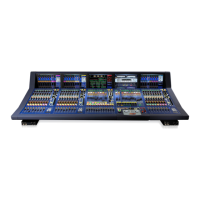311
XL8 Control Centre
Operator Manual
Glossary
This section provides an explanation of some of the symbols, terms and abbreviations used in this
manual.
µ: Micro- prefix symbol that represents 10
-6
or
one millionth.
A/D: Abbreviation for “analogue to digital”. The
conversion of a continuous signal into a numeric
discrete sample sequence.
AES3: Also known as “AES/EBU”, this is a serial
interface for transferring digital audio between
devices.
AES50: AES digital audio engineering standard.
AES50 is a high resolution, multi-channel audio
interconnection (HRMAI). Rather than a
network, it is a high-performance, point-to-point
audio interconnection, although the auxiliary
data may operate as a true network,
independently of the audio. HRMAI provides a
professional multi-channel audio interconnection
that uses Cat5 data cable and is compatible with
Ethernet networks.
AES/EBU: Abbreviation for “Audio Engineering
Society/European Broadcasting Union”; see
AES3.
AFL: Abbreviation for “after fader listen”.
amp (A): Unit of current; short for “ampere”.
Area A: Primary input control area.
Area B: A secondary input control area.
Assignable controls: Any controls, such as
select buttons (LCD switches), that can be set
up by the user to control any function required.
Auto safe: Prevents channel from accepting
scene recall.
Auto-mute: A function that automatically
mutes the channel’s signal under certain
conditions.
Auto-mute group: A function that
automatically mutes a number of selected
channels under certain conditions.
Automation: 1. Memorization and playback of
changes made to mixer settings. 2. An area on
the output bay that controls these.
Aux: Abbreviation for “auxiliary send” or “aux
send”. A designation for extra buses, typically
used for sending signal to effects, headphone
amps and other destinations. See Bus.
Aux send: See Aux.
Balanced: A type of audio connection that uses
the three leads in a cable, connector and jack as
part of a phase-cancelling arrangement to boost
the signal and reduce noise.
Band: In EQ, a range of frequencies.
Bandwidth: In EQ, the width of a band, that is,
the number of frequencies that will be
boosted/cut above and below a centre
frequency.
Bank: A fixed number of channels displayed on
a GUI screen.
Bass: Lower frequencies in a signal.
Bay: One of the five main control centre
sections, which contains a control surface and a
GUI screen.
Bus: A pathway down which one or more signals
can travel. A bus can be aux, sub, main,
master, mix or solo.
Channel: Single path taken by an audio signal
(input or output) through the control centre.
Channel select button: LCD button in the
input and output fast strips for channel
selection. The backlight colour and displayed
text are user-configurable for easy
identification.
Channel strip: Row of controls in traditional
analogue layout used for the shaping of a signal.
CMR: Abbreviation for “common mode
rejection”. A measure of how well a differential
amplifier rejects a signal that appears
simultaneously and in-phase at both input
terminals. CMR is usually stated as a dB ratio at
a given frequency.
Comb filtering: Removal of signal components
at a number of regularly spaced frequencies.
Compressor: A dynamics processor that
reduces the level of any signal exceeding a
specified threshold volume.
Condenser microphone: A high quality mic
that uses a capacitor to detect changes in the
ambient air pressure, which it then converts into

